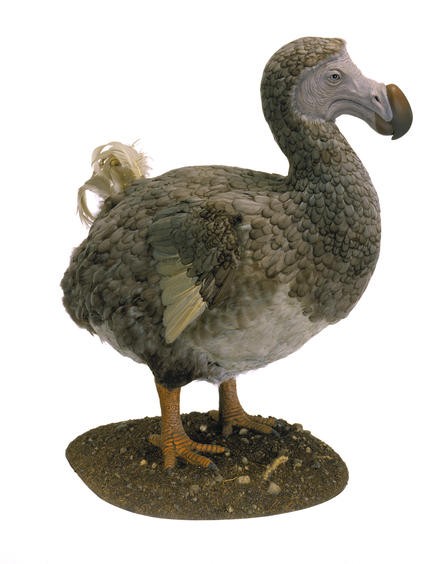By Ana Verayo, | February 24, 2016

A model of a dodo that will be on display in the Museum’s upcoming exhibition about the relationships between birds and dinosaurs, Dinosaurs Among Us.
The dodo bird which is a famous, extinct bird could have been a rather intelligent species according to a new study, as the bird has been labeled as a symbol of stupidity.
In this new study, fossilized evidence reveal that the overall brain size of the dodo bird is in direct proportion to its body size, which is similar to one of its living bird relatives, the pigeons, where these birds are known for their excellent navigational capabilities.
Like Us on Facebook
Scientifically known as the Raphus cucullatus, this rather large, flightless bird used to thrive in an island across the Indian Ocean known as Mauritius, where the last of the birds were seen alive in 1662. As European sailors discovered this island during the late 1500s, the dodo were apparently not wary of these foreigners, eventually becoming easy prey for these visiting boats and a favorite meal by these sailors.
According to Eugenia Gold from The American Museum of Natural History's Richard Gilder Graduate School, due to this kind of behavior and how other invasive species were introduced to this island, the dodo bird disappeared in less than a century after humans settled on the island.
Gold adds how they are exclusively known for becoming extinct, where people labeled the dodo for having a dumb reputation. The dodo has already become an icon in pop culture however, its biological aspects are largely unknown, since specimens are extremely rare to come by, according to researchers.
In order to examine the brain structure of a dodo, the team searched for a well preserved skull from the esteemed collections housed under London's Natural History Museum where they obtained high resolution images of the bird including CT scans (computed tomography) that can produce images of the brain based on the shape of the skull.
Apart from the dodo, Gold also scanned the skulls of several other bird species for further comparison such as pigeons. Fellow researchers from the Natural History Museum of Denmark and the National Museum of Scotland also delivered some endocasts based on the dodo bird's closest relative, the Rodrigues solitaire or the Pezophaps solitaria, which is also now extinct.
The analysis revealed how the dodo's brain was just about average for its body size. Gold says that if someone uses brain size as a determining factor for intelligence, the dodo probably possessed a similar level of intelligence to pigeons. She adds how intelligence is not just based on the overall brain size, but this measurement gives a basic idea.
Since the dodo's brain size is apparently not that small at all than first thought, researchers also revealed some unexpected findings. The dodo and the Rodrigues solitaire apparently had very large olfactory bulbs which means that this is unusual for birds since they rely more on vision however, since both of the species were ground dwellers, they rely more on smell than sight to hunt for food, making a large olfactory lobe an evolutionary advantage.
This new study is published in the Zoological Journal of the Linnean Society.
-
Use of Coronavirus Pandemic Drones Raises Privacy Concerns: Drones Spread Fear, Local Officials Say

-
Coronavirus Hampers The Delivery Of Lockheed Martin F-35 Stealth Fighters For 2020

-
Instagram Speeds Up Plans to Add Account Memorialization Feature Due to COVID-19 Deaths

-
NASA: Perseverance Plans to Bring 'Mars Rock' to Earth in 2031

-
600 Dead And 3,000 In The Hospital as Iranians Believed Drinking High-Concentrations of Alcohol Can Cure The Coronavirus

-
600 Dead And 3,000 In The Hospital as Iranians Believed Drinking High-Concentrations of Alcohol Can Cure The Coronavirus

-
COVID-19: Doctors, Nurses Use Virtual Reality to Learn New Skills in Treating Coronavirus Patients







